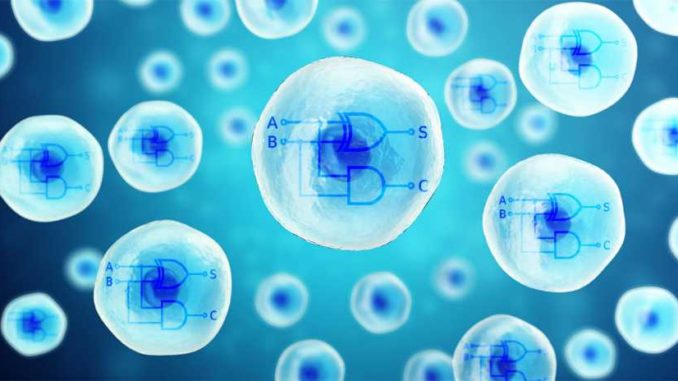
Views: 37
16.04.2019 | News By: Peter Rüegg
ETH researchers have integrated two CRISPR-Cas9-based core processors into human cells. This represents a huge step towards creating powerful biocomputers.
Courtesy ETH: Controlling gene expression through gene switches based on a model borrowed from the digital world has long been one of the primary objectives of synthetic biology. The digital technique uses what are known as logic gates to process input signals, creating circuits where, for example, output signal C is produced only when input signals A and B are simultaneously present.
To date, biotechnologists had attempted to build such digital circuits with the help of protein gene switches in cells. However, these had some serious disadvantages: they were not very flexible, could accept only simple programming, and were capable of processing just one input at a time, such as a specific metabolic molecule. More complex computational processes in cells are thus possible only under certain conditions, are unreliable, and frequently fail.
Even in the digital world, circuits depend on a single input in the form of electrons. However, such circuits compensate for this with their speed, executing up to a billion commands per second. Cells are slower in comparison, but can process up to 100,000 different metabolic molecules per second as inputs. And yet previous cell computers did not even come close to exhausting the enormous metabolic computational capacity of a human cell.
A CPU of biological components
A team of researchers led by Martin Fussenegger, Professor of Biotechnology and Bioengineering at the Department of Biosystems Science and Engineering at ETH Zurich in Basel, have now found a way to use biological components to construct a flexible core processor, or central processing unit (CPU), that accepts different kinds of programming. The processor developed by the ETH scientists is based on a modified CRISPR-Cas9 system and basically can work with as many inputs as desired in the form of RNA molecules (known as guide RNA).
A special variant of the Cas9 protein forms the core of the processor. In response to input delivered by guide RNA sequences, the CPU regulates the expression of a particular gene, which in turn makes a particular protein. With this approach, researchers can program scalable circuits in human cells – like digital half adders, these consist of two inputs and two outputs and can add two single-digit binary numbers.
Powerful multicore data processing
The researchers took it a step further: they created a biological dual-core processor, similar to those in the digital world, by integrating two cores into a cell. To do so, they used CRISPR-Cas9 components from two different bacteria. Fussenegger was delighted with the result, saying: “We have created the first cell computer with more than one core processor.”
This biological computer is not only extremely small, but in theory can be scaled up to any conceivable size. “Imagine a microtissue with billions of cells, each equipped with its own dual-core processor. Such ‘computational organs’ could theoretically attain computing power that far outstrips that of a digital supercomputer – and using just a fraction of the energy,” Fussenegger says.
Applications in diagnostics and treatment
A cell computer could be used to detect biological signals in the body, such as certain metabolic products or chemical messengers, process them and respond to them accordingly. With a properly programmed CPU, the cells could interpret two different biomarkers as input signals. If only biomarker A is present, then the biocomputer responds by forming a diagnostic molecule or a pharmaceutical substance. If the biocomputer registers only biomarker B, then it triggers production of a different substance. If both biomarkers are present, that induces yet a third reaction. Such a system could find application in medicine, for example in cancer treatment.
“We could also integrate feedback,” Fussenegger says. For example, if biomarker B remains in the body for a longer period of time at a certain concentration, this could indicate that the cancer is metastasising. The biocomputer would then produce a chemical substance that targets those growths for treatment.
Multicore processors possible
“This cell computer may sound like a very revolutionary idea, but that’s not the case,” Fussenegger emphasises. He continues: “The human body itself is a large computer. Its metabolism has drawn on the computing power of trillions of cells since time immemorial.” These cells continually receive information from the outside world or from other cells, process the signals and respond accordingly – whether it be by emitting chemical messengers or triggering metabolic processes. “And in contrast to a technical supercomputer, this large computer needs just a slice of bread for energy,” Fussenegger points out.
His next goal is to integrate a multicore computer structure into a cell. “This would have even more computing power than the current dual core structure,” he says.
Reference
Kim H, Bojar D, Fussenegger M. CRISPR-CPU: A CRISPR/Cas9-based central processing unit to program complex logic computations in human cells. PNAS, April 9, 2019, 116 (15) 7214-7219; doi: 10.1073/pnas.1821740116
Leave a Reply